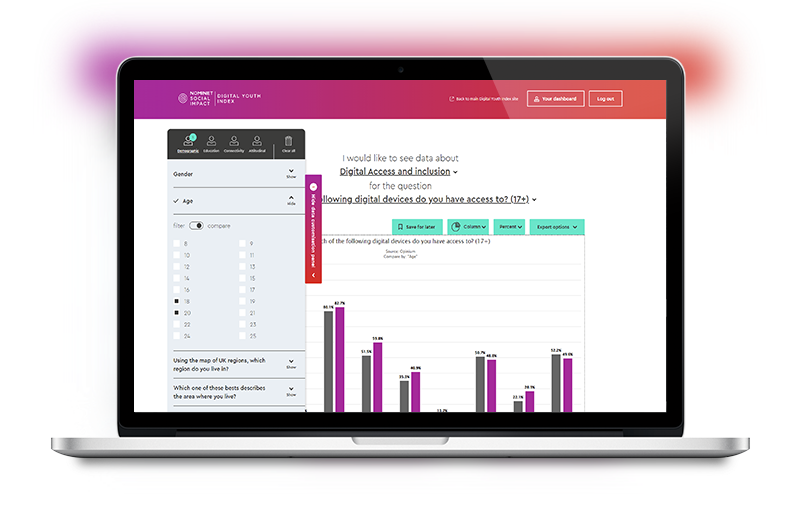The Nominet Digital Youth Index is a benchmarking tool comprising of quantitative and qualitative data on young people’s digital lives; their attitudes, behaviours, perceptions, and experiences.
The tool encompasses five pillars covering wellbeing, safety, skills, connectivity, and access. Here, we’re going to explore each of these pillars in more detail and share some key findings and statistics from year two of our research for each.
We’ll mention index score as we explore the pillars, this is a score out of 100 that is calculated by combining responses to a core set of questions from the survey. The maximum score is 100, being the best possible outcome for each pillar, and it provides a relative measure that can be used to identify priorities for improvement, track trends and compare groups.
Digital Access
“To have good digital access the young person must be able to access and use a ‘critical’ digital device (smartphone, laptop, tablet, or desktop) whenever they need to, and the device must be fit for purpose.”
This pillar explores how many young people have access to critical digital devices, such as smartphones and laptops, when access might be limited or unachievable and the reasons for this.
At a glance…
Digital access is an issue for all young people, in fact this is a critical area to address alongside digital wellbeing.
Looking at some of the numbers in more detail, the Digital Youth Index shows that boys/young men are more impacted when we look at the Index scores, with the higher score showing a better outcome, (60%) compared to girls/young women (65%). When you look at education stages, there’s lower digital access among those of junior school age (55%) compared to secondary school age (63%) and young adults (64%).
If we compare living arrangements and household income, there are some strong links. Lower income households (earning up to £20,000 per year) have a digital access score of only 57 out of 100 compared to those in the upper income tier (earning over £80,000 per year) who score 68 out of 100. Living arrangements also seem to impact digital access with young people living in care having lower levels of access.
When we delve into the data via UK Nations and Regions, Northern Ireland has the lowest digital access score while Wales has the highest.

Digital Connectivity
“To achieve a high index score for connectivity a young person must have a ‘good quality’ internet connection at home and, if applicable, a good quality mobile data connection. Where ‘good quality’ means the connection is fast and reliable enough to access and use the internet to complete the tasks that they want to do.”
This pillar consists of data around the types of internet connections young people have access to, how frequently they use them and explores other issues such as connection quality, storage and data allowances and access to quiet working spaces.
At a glance…
The cost-of-living crisis has had a clear impact on digital connectivity. In fact, over a fifth of respondents said they are struggling to pay household bills, with 10% having to change or cancel internet packages. There’s also a clear correlation when it comes to household income, with those living in lower-income households having a lower connectivity score (65 out of 100) than the upper income tier (75 out of 100).
21% of respondents are struggling to pay their household bills each month
Interestingly, there also seems to be an unexpected difference in gender when we look at connectivity, with young men/boys scoring 66% compared to young women/girls at 70%.
10% have had to change or cancel their internet package due to the cost-of-living crisis
Digital Wellbeing
“Positive digital wellbeing means the young person feels in control of what they see and do online, they are happy with the amount of time they spend on their digital devices, and overall, their use of the internet and digital devices has a positive impact on their life (relationships, school, work, physical and mental health).”
Our Digital Wellbeing pillar consists of questions covering where young people seek advice, how much time they spend online, how this impacts other areas of life and explores statements around isolation.
At a glance…
Again, digital wellbeing is an issue for all young people, and is a critical area which needs addressing alongside digital access. Young women/girls are impacted more than young men/boys and there is a clear link between sexual orientation and digital wellbeing, with those identifying as heterosexual scoring much higher than those in the LGBTQ+ community.
When it comes to location, young people living in urban areas seem to fare better when it comes to digital wellbeing (67 out of 100) than those in suburban (63 out of 100) and rural (62 out of 100) areas.
Digital Safety
“The index evaluates the awareness, understanding and abilities of young people to stay safe across several elements that contribute to digital safety, e.g., keeping personal data safe, mitigating viruses, patching software, password security, privacy settings, phishing, and identifying secure websites. It also measures the extent to which they feel safe, regardless of their knowledge and abilities, and if they have experienced anything online that has caused them harm or distress, such as discrimination, bullying, or sexual content.”
This pillar explores levels of awareness for internet safety, experiences of safety online, finding support and exposure to issues such as fake news, hate speech and trolling.
At a glance…
While the overall digital safety index is the same for both boys/young men and girls/young women, girls/young women are more likely to experience distressing content online. There are also significant differences in online experience when we consider sexual orientation, with young people in the LGBTQ+ community being twice as likely to experience hate speech online, trolling or abuse from strangers, exposure to sexual content and content that promotes self-harm or suicide.
Girls/young women are twice as likely to be asked to share inappropriate or sexual images online.
Digital Skills
“The index score for digital skills is a measure of ability calculated by evaluating a young person’s ability to carry out twelve tasks, e.g., use the internet to help with schoolwork. To obtain a high score, they must find several of the tasks easy to complete.”
The digital skills pillar explores how young people learn digital skills, how easy they find this and explores statements around training in digital skills for future careers.
At a glance…
There are interesting differences when it comes to the level of interest in digital skills and career aspirations and gender, with boys/young men being more interested in pursuing careers which use advanced digital skills (64% male vs. 47% female) and considering that digital skills are essential to future jobs (78% male vs. 71% female).
Ethnic minority groups are also more likely to consider digital skills essential to future careers and would like a job using these skills.
Comparing Index Scores across the pillars
The below table highlights that where there is scope for improvement across all five pillars, the most critical areas to address are digital access and digital wellbeing, which fall below the overall index scores at a national level. Digital connectivity is also the third pillar which needs some focus.

Looking to dig a bit deeper into these findings and explore the data for yourself? Use our data tool to uncover insights around young people’s attitudes, behaviours, perceptions and experiences of growing up online.

Tom Baynton, Market Analyst, Nominet
Tom is a Market Analyst at Nominet, having joined the organisation in 2014 from the research agency Kantar TNS. He supports the UK registry and Social Impact teams by conducting research and analysing market and registry data. He has worked on the Digital Youth Index since its inception in 2021, with a specific focus on co-development of the DYI data tool.
Share this article










